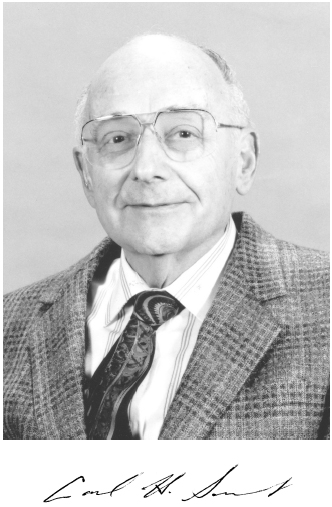
1922–1996
Elected in 1995
“For advancing technology of geophysical exploration and providing leadership within the larger social and environmental context.”
BY NORMAN NEIDELL SUBMITTED BY THE NAE HOME SECRETARY
CARL H. SAVIT, an exemplary geophysicist, passed away on March 21, 1996, after a valiant battle with colon cancer. His lucid presentations during his career made him both known and respected throughout the geophysical world. He was such a visible and able spokesman for the profession and the industry that his technical and other accomplishments may not get their due.
His career progressed with purpose and direction. He was assistant for earth, sea, and air sciences to the president’s science advisor as well as a scientist who authored 40 US patents, with corresponding patents in other countries. One of his patents describes the Society of Exploration Geophysicists’ (SEG) standard “A” format, which is now so familiar that few recollect how it evolved. He also convinced the US government to adopt a position with regard to offshore seismic survey data that both ensured US rights of access (necessary for conducting lease sales and resource evaluations) and saved taxpayers hundreds of millions of dollars by eliminating the need for immense data storage. He was among the first to recognize the role of color displays and attributes computed from basic seismic data for interpretive purposes. His update of Dobrin’s classic textbook Introduction to Geophysical Prospecting (1988) was a landmark in documenting and communicating the technology of his profession.
Carl was born in 1922 in New York and spent seven years of his childhood in Medellín, Colombia. Clearly a mathematical prodigy, he received his BS degree from the California Institute of Technology in 1942 (at age 20) and his MS degree, both in mathematics, a year later. While a graduate student, he worked briefly with the Army Air Corps in meteorology and later as an officer (second lieutenant) on upper atmospheric physics.
He married Sandra Kaplan in 1946, his lifelong sweetheart. In later years she served as his honorary executive assistant. In 1948 he joined Western Geophysical Co. of America, where he advanced from chief mathematician to senior vice president, technology. Thanks to his contributions and leadership Western always stood in the front ranks of geophysical technology.
Carl’s insights were a remarkable guide to the future—he demonstrated an intuition that led him to focus on technology that was always ahead of the industry. For example, during the early 1950s he recognized a need to determine interval velocities from seismic data in a routine way and developed a method that could accommodate variable survey configurations. A specially prepared slide rule also treated computations for curved seismic reflection ray paths. Shortly thereafter he developed the first method of joint use of seismic reflection and refraction information, including a way to determine the normal depth to a refractor from unreversed profiles. Works of this type become an area for research and development many years later. Four or five of his patents during this period dealt with the first, and for many years only, practical method of accurately handling 24-fold common depth point (CDP) data from analog tapes.
Toward the end of the 1950s Carl was concerned with the role of seismic amplitudes and “bright spots” while most of the rest of the industry sought to obliterate such information in the name of improving reflector homogeneity and continuity. His papers in Geophysics and the Oil and Gas Journal document his foresight, which again is now second nature to us all. In 1960 he was named a Classic Author of Geophysics.
During the 1960s Carl’s projects included the first use of multitrace reflection and refraction shooting (including CDP
work) in the deep ocean as well as participation in the design and development of the first digital array processor by IBM. He then turned his attention to systems with large numbers of recorded channels and color displays of seismic data.
Carl recognized the talents of others and moved them along rapidly to benefit both their careers and the organization. Many prominent geophysicists owe him much for their success. Litton Industries (then parent company of Western) awarded him its Advanced Technology Achievement Award for precisely these reasons and in recognition of his scientific acumen.
He was always very active in industry and geophysical society affairs. He served as president of SEG and the International Association of Geophysical Contractors (IAGC), editor of Geophysics (the principal technical journal of SEG), general chairman of the SEG annual meeting held in Mexico City (no small logistical feat), and (starting in the 1960s) was a prominent spokesman for the industry in legal and governmental matters. He took a leave of absence from Western in 1970 and spent 14 months in Washington working on behalf of the industry. He received SEG’s Kauffman Gold Medal in 1979 for his role as an “industry spokesman” and in 1980 was designated a SEG honorary member. He also served as President of the National Ocean Industries Association.
As a spokesman and representative of Western, SEG, the IAGC, and other activities, Carl was both charming and effective. He spoke a few words of many languages (including Russian) and was not shy about using this talent. He was a man of exquisite taste and well known in many of the finer restaurants. His personality and keen sense of humor made him a valued friend and confidante to many at all levels of any organization.
Carl is survived by his wife Sandra, son Mark, daughters Debby and Judi, eight grandchildren, four great-grandchildren, and a grateful profession. He was a great husband, father, grandfather, diplomat, patriot, scholar, scientist, teacher, innovator, and pioneer. Those who worked with him and all who knew him were privileged indeed.




